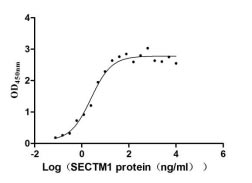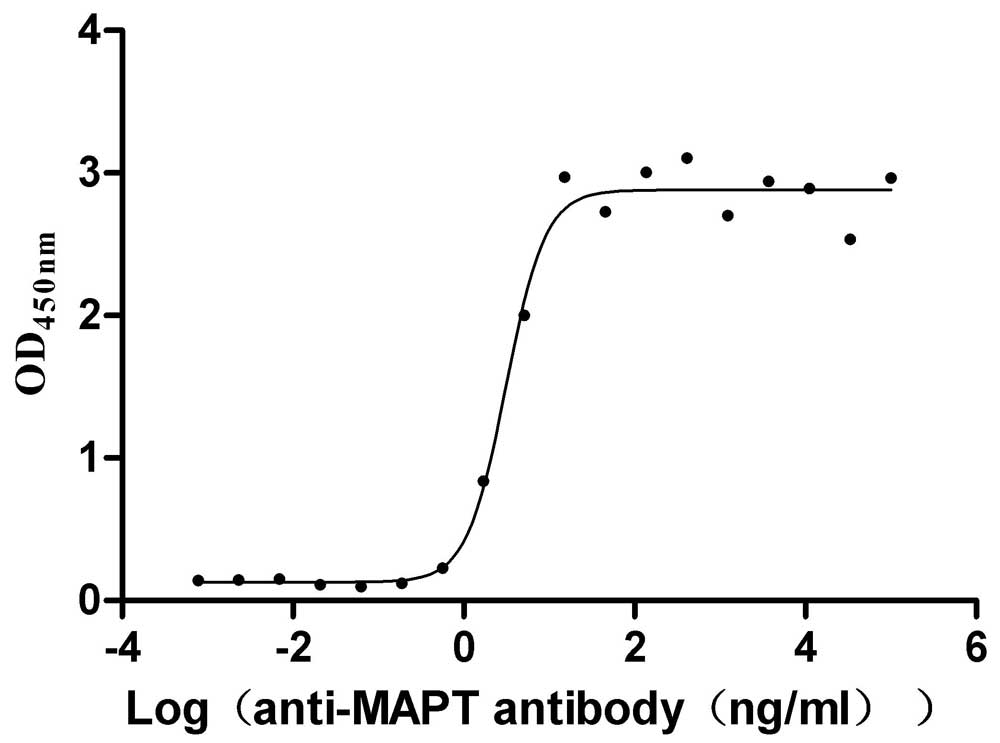Recombinant Human Nucleolar protein 3 (NOL3)
-
货号:CSB-YP015921HU
-
规格:
-
来源:Yeast
-
其他:
-
货号:CSB-EP015921HU-B
-
规格:
-
来源:E.coli
-
共轭:Avi-tag Biotinylated
E. coli biotin ligase (BirA) is highly specific in covalently attaching biotin to the 15 amino acid AviTag peptide. This recombinant protein was biotinylated in vivo by AviTag-BirA technology, which method is BriA catalyzes amide linkage between the biotin and the specific lysine of the AviTag.
-
其他:
-
货号:CSB-BP015921HU
-
规格:
-
来源:Baculovirus
-
其他:
-
货号:CSB-MP015921HU
-
规格:
-
来源:Mammalian cell
-
其他:
产品详情
-
纯度:>85% (SDS-PAGE)
-
基因名:NOL3
-
Uniprot No.:
-
别名:Apoptosis repressor with CARD; ARC; Muscle enriched cytoplasmic protein; Muscle-enriched cytoplasmic protein; MYC; MYP; Nol3; NOL3_HUMAN; NOP; Nop30; Nucleolar protein 3 (apoptosis repressor with CARD domain) ; Nucleolar protein 3; Nucleolar protein of 30 kDa
-
种属:Homo sapiens (Human)
-
蛋白长度:Full length of Isoform 2
-
表达区域:1-208
-
氨基酸序列MGNAQERPSETIDRERKRLVETLQADSGLLLDALLARGVLTGPEYEALDALPDAERRVRRLLLLVQGKGEAACQELLRCAQRTAGAPDPAWDWQHVGPGYRDRSYDPPCPGHWTPEAPGSGTTCPGLPRASDPDEAGGPEGSEAVQSGTPEEPEPELEAEASKEAEPEPEPEPELEPEAEAEPEPELEPEPDPEPEPDFEERDESEDS
-
蛋白标签:Tag type will be determined during the manufacturing process.
The tag type will be determined during production process. If you have specified tag type, please tell us and we will develop the specified tag preferentially. -
产品提供形式:Lyophilized powder
Note: We will preferentially ship the format that we have in stock, however, if you have any special requirement for the format, please remark your requirement when placing the order, we will prepare according to your demand. -
复溶:We recommend that this vial be briefly centrifuged prior to opening to bring the contents to the bottom. Please reconstitute protein in deionized sterile water to a concentration of 0.1-1.0 mg/mL.We recommend to add 5-50% of glycerol (final concentration) and aliquot for long-term storage at -20℃/-80℃. Our default final concentration of glycerol is 50%. Customers could use it as reference.
-
储存条件:Store at -20°C/-80°C upon receipt, aliquoting is necessary for mutiple use. Avoid repeated freeze-thaw cycles.
-
保质期:The shelf life is related to many factors, storage state, buffer ingredients, storage temperature and the stability of the protein itself.
Generally, the shelf life of liquid form is 6 months at -20°C/-80°C. The shelf life of lyophilized form is 12 months at -20°C/-80°C. -
货期:Delivery time may differ from different purchasing way or location, please kindly consult your local distributors for specific delivery time.Note: All of our proteins are default shipped with normal blue ice packs, if you request to ship with dry ice, please communicate with us in advance and extra fees will be charged.
-
注意事项:Repeated freezing and thawing is not recommended. Store working aliquots at 4°C for up to one week.
-
Datasheet :Please contact us to get it.
相关产品
靶点详情
-
功能:May be involved in RNA splicing.; Functions as an apoptosis repressor that blocks multiple modes of cell death. Inhibits extrinsic apoptotic pathways through two different ways. Firstly by interacting with FAS and FADD upon FAS activation blocking death-inducing signaling complex (DISC) assembly. Secondly by interacting with CASP8 in a mitochondria localization- and phosphorylation-dependent manner, limiting the amount of soluble CASP8 available for DISC-mediated activation. Inhibits intrinsic apoptotic pathway in response to a wide range of stresses, through its interaction with BAX resulting in BAX inactivation, preventing mitochondrial dysfunction and release of pro-apoptotic factors. Inhibits calcium-mediated cell death by functioning as a cytosolic calcium buffer, dissociating its interaction with CASP8 and maintaining calcium homeostasis. Negatively regulates oxidative stress-induced apoptosis by phosphorylation-dependent suppression of the mitochondria-mediated intrinsic pathway, by blocking CASP2 activation and BAX translocation. Negatively regulates hypoxia-induced apoptosis in part by inhibiting the release of cytochrome c from mitochondria in a caspase-independent manner. Also inhibits TNF-induced necrosis by preventing TNF-signaling pathway through TNFRSF1A interaction abrogating the recruitment of RIPK1 to complex I. Finally through its role as apoptosis repressor, promotes vascular remodeling through inhibition of apoptosis and stimulation of proliferation, in response to hypoxia. Inhibits too myoblast differentiation through caspase inhibition.
-
基因功能参考文献:
- Results show that in response to DNA damage, p53 total levels increase proportionally to the strength of the damage; however, p53 tetramers are formed at a constant rate under the control of ARC protein. PMID: 25344068
- role of apoptosis repressor with a CARD domain (ARC) in the therapeutic resistance of renal cell carcinoma PMID: 28464919
- a novel genetic primary myelofibrosis-like mouse model and identify a tumor suppressor role for NOL3 in the pathogenesis of myeloid malignancies. PMID: 28232469
- Increased ARC expression is associated with liver metastasis of colorectal cancer. PMID: 26721253
- RUNX3, miR-185 and ARC regulate the sensitivity of gastric cancer cells to chemotherapy. PMID: 24763054
- ARC is regulated via BIRC2/MAP3K14 signalling and its overexpression in AML or MSCs can function as a resistant factor to birinapant-induced leukaemia cell death. PMID: 25079338
- high expression of ARC plays an important role in the pathogenesis of nasopharyngeal carcinoma and leads to X-radiation and cisplatin resistance in nasopharyngeal carcinoma. PMID: 23877130
- ARC is a previously unrecognized inhibitor of apoptosis in beta-cells and that its protective effects are mediated through suppression of the ER stress response pathway. PMID: 22933109
- This study utilized unbiased, genome-wide approaches to identify a NOL3 mutation that likely causes Familial cortical myoclonus. PMID: 22926851
- HIF-1alpha directly bound to hypoxia-responsive element located at -419 to -414 of ARC gene, which is essential for HIF-1-induced expression. PMID: 22475487
- Data show that ARC promotes breast carcinogenesis by driving primary tumor growth, invasion, and metastasis as well as by promoting chemoresistance in invasive cells. PMID: 22037876
- ARC, previously unlinked to pulmonary hypertension, is a critical determinant of vascular remodeling in this syndrome. PMID: 22082675
- Results suggest that ARC expression levels are highly prognostic in AML and that ARC is a potential therapeutic target in AML. PMID: 21041716
- Ras induces ARC in epithelial cancers, and ARC plays a role in the oncogenic actions of Ras PMID: 20392691
- These results suggest that the antiapoptotic effect of apoptotic repressor with caspase recruitment domain is, in part, due to inhibition of voltage-gated potassium channels in cardiomyocytes. PMID: 12734105
- calcium binding mediates regulation of caspase 8 and cell death by ARC PMID: 15509781
- Unexpectedly, ARC was localized almost exclusively to the nuclei of cancer cells, which was unlike the cytoplasmic localization of ARC in non-cancer cells PMID: 15848180
- ARC was present in the cytoplasm and nuclei of epithelial cells in invasive ductal carcinoma PMID: 15861191
- is downregulated in human failing myocardium PMID: 16505176
- nuclear apoptosis repressor with caspase recruitment domain (ARC)is induced in cancer cells and negatively regulates p53 PMID: 18087040
- the high level of ARC protein and the constitutive phosphorylation of ARC in cancer cells may play an important role in the protection of cancer cells against oxidative stress PMID: 18172857
- Transfection of cDNA encoding ARC into Me1007 cells inhibited both caspase-8 activation and apoptosis induced by thapsigargin or tunicamycin. PMID: 18245485
- ARC is a novel marker of human colon cancer and suggest that it may be a general feature of epithelial cancers. PMID: 18469522
- the balance between antiapoptotic ARC and proapoptotic caspase-8 is the only one to be disturbed during carcinogenesis and tumour progression of renal cell carcinomas PMID: 18516683
- ARC undergoes poly-ubiquitination and subsequent proteasome-dependent degradation. Mutation of ARC's lysine residues prevents this and enhances its pro-survival effects. PMID: 17142452
- ARC holds multiple death pathways in check by non-homotypic death-fold interactions. Loss of ARC disinhibits these, leading to accelerated DISC assembly and Bax activation and may be an apoptotic trigger in heart failure and ischemia-reperfusion. PMID: 15383280
- The CARD of ARC binds the Bax C-terminus, preventing Bax activation and activation of the intrinsic mitochondrial pathway PMID: 15383280
- ARC is recruited to the Fas DISC. By interacting with Fas and FADD through CARD-DD and CARD-DED interactions, ARC prevents DISC assembly and procaspase-8 activation. PMID: 15383280
显示更多
收起更多
-
相关疾病:Myoclonus, familial cortical (FCM)
-
亚细胞定位:[Isoform 1]: Nucleus, nucleolus.; [Isoform 3]: Cytoplasm.; [Isoform 2]: Cytoplasm. Mitochondrion. Sarcoplasmic reticulum. Membrane; Lipid-anchor.
-
组织特异性:Highly expressed in heart and skeletal muscle. Detected at low levels in placenta, liver, kidney and pancreas.
-
数据库链接:
HGNC: 7869
OMIM: 605235
KEGG: hsa:8996
STRING: 9606.ENSP00000268605
UniGene: Hs.513667
Most popular with customers
-
Recombinant Human Secreted and transmembrane protein 1 (SECTM1), partial (Active)
Express system: Mammalian cell
Species: Homo sapiens (Human)
-
Recombinant Mouse Prolactin receptor (Prlr), partial (Active)
Express system: Mammalian cell
Species: Mus musculus (Mouse)
-
Recombinant Human E3 ubiquitin-protein ligase ZNRF3 (ZNRF3), partial (Active)
Express system: Mammalian cell
Species: Homo sapiens (Human)
-
Recombinant Human B-lymphocyte antigen CD20 (MS4A1)-VLPs (Active)
Express system: Mammalian cell
Species: Homo sapiens (Human)
-
Recombinant Macaca mulatta Microtubule-associated protein tau (MAPT) (Active)
Express system: Mammalian cell
Species: Macaca mulatta (Rhesus macaque)
-
Recombinant Macaca fascicularis Claudin (CLDN18)-VLPs (Active)
Express system: Mammalian cell
Species: Macaca fascicularis (Crab-eating macaque) (Cynomolgus monkey)
-
Recombinant Human Trophoblast glycoprotein (TPBG), partial (Active)
Express system: Mammalian cell
Species: Homo sapiens (Human)
-
Recombinant Human Interleukin-2 (IL2) (Active)
Express system: Mammalian cell
Species: Homo sapiens (Human)




















